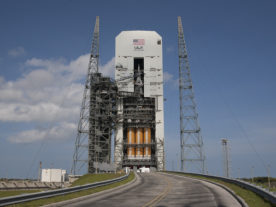Huge Asteroid Won’t Hit Us After All
The NASA/JPL Near-Earth Object Program Office says that we can all breathe easier now: Reports indicating that a gigantic asteroid is heading our way and would possibly impact the Earth are not true.
The 400-meter wide ‘2014 UR116’ asteroid, found on October 27 at the MASTER-II observatory in Kislovodsk, Russia does occasionally pass by Earth as it orbits the Sun over a three year period. But the huge hunk of rock really isn’t a threat to us, since it really doesn’t come close enough to the Earth as it makes it way around the Sun to cause a problem, according to the U.S. space agency.
NASA/JPL goes on to say that Tim Spahr, the Director of the International Astronomical Union’s (IAU) Minor Planet Center in Cambridge Massachusetts, re-calculated the orbital path of the asteroid after he noticed that it was the same object that had been observed about six years ago.
Using the Sentry System at the Jet Propulsion Laboratory, NASA took Spahr’s calculations further and found that the asteroid doesn’t pose any threat to Earth or any of the solar systems other planet for at least the next 150 years.

A new kind of stretchy “electronic skin” (blue patch) is the first to be able to detect directional pressure.
(American Chemical Society)
New Artificial Skin Senses Pressure Strength and Direction
A group of South Korean scientists have developed an artificial skin that they say can detect not only pressure, but also what direction that pressure is coming from.
Writing in the American Chemical Society’s journal ACS NANO, the researchers, led by Hyunhyub Ko, said their new ‘electronic skin’ is a flexible, film-like mechanism that can perform a number of tasks, including sensing pressure, reading brain activity and monitoring heart rate.
The research team wanted to develop an artificial skin that could ‘feel’ in three dimensions.
To provide that enhanced sense of touch, the researchers made their skin out of tiny domes of material that can mesh with each other and deform when something pokes it or blows air across it.
The researchers said that the construction of their artificial skin allows the user to sense the location, intensity and direction of each touch, vibration and air flow that is applied to the skin.
This new wearable skin, which was modeled after human skin, could prove to be useful in developing prosthetic limbs, robotic skins and rehabilitation devices, said the researchers.

Trauma patient being rushed to surgery
Link Between Internet Searches and ER Visits Found
A new Swedish study found a significant link between the amount of Internet searches that were conducted on a regional medical website and the number of next-day visits to nearby emergency rooms (ERs).
The Swedish researchers used Google Analytics for one year to tally and graph Internet searches of the Stockholm Health Care Guide and then compared the data to ER visits over the same time period.
Being able gauge the demand for emergency medical services ahead of time could help hospital administrators provide resources and personnel when needed most, and prepare medical providers such as doctors and nurses for any sudden high demand for services.
The researchers say that their study, which was recently published online in the “Annals of Emergency Medicine,” suggests that Internet search data may someday be used to help forecast ER needs at local or regional hospitals.
























Comments are closed.